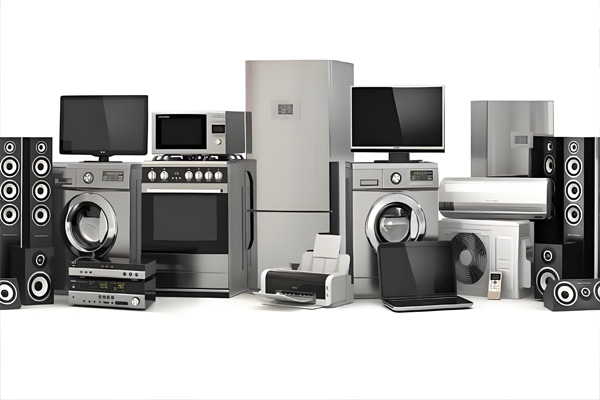The application of engineering plastics in the household appliance industry is extensive and in-depth, and its excellent performance (such as lightweight, high temperature resistance, insulation, chemical corrosion resistance, etc.) has promoted the innovation and upgrading of household appliances. The following is an analysis of its core application areas, technological trends, and future development directions:
1、 Main types and applications of engineering plastics
Polycarbonate (PC) and PC/ABS alloy
Applications: Home appliance casings (such as rice cookers, vacuum cleaners, microwave ovens), transparent panels, display components.
Advantages: PC has high transparency and impact resistance. PC/ABS alloy combines the heat resistance of PC with the ease of processing of ABS, and the surface does not require spraying, making it more environmentally friendly.
Polybutylene terephthalate (PBT)
Application: Steam valve for rice cookers, motor bracket for washing machines, fan blades for air conditioning, internal bracket for microwave ovens.
Features: High temperature resistance (long-term use temperature up to 140 ° C), hydrolysis resistance, and dimensional stability. DuPont PBT has improved its steam resistance through modification technology and solved the whitening problem caused by the precipitation of flame retardants.
Polyamide (PA, Nylon)
Application: Enhanced grade PA6/PA66 is used for components such as gears, transmission parts, and motor brackets that require high wear resistance. For example, the German Langsheng BG-50S PA6 is used for home appliance casings and structural components, combining mechanical strength and chemical resistance.
Polyoxymethylene (POM)
Application: Scenes requiring high rigidity and low friction, such as washing machine turbines, microwave oven gears, and sliding components. Its wear resistance is close to metal, but the cost is lower.
Special engineering plastics (PPS, PEEK, LCP, etc.)
Application: Components in high-temperature environments (such as oven door frames, coffee machine casings), high-frequency connectors (5G home appliances). PEEK is used in high-end kitchen appliances due to its food contact safety (excluding PFAS).
2、 Core advantages and technological innovation
Lightweight and energy-saving
The density of engineering plastics is only 1/4-1/7 of that of metals, which can significantly reduce the weight of household appliances and improve energy efficiency. For example, replacing metal with PBT reduces the weight of washing machine counterweights by 30%.
High temperature resistance and safety
Materials such as PPS can withstand temperatures up to 260 ° C, while LCP is used for high-frequency connectors to reduce signal loss and meet the high-power requirements of smart home appliances.
Environmental Protection and Sustainable Development
Halogen free flame retardant technology: Materials such as PC/ABS comply with the RoHS directive, avoiding the use of harmful flame retardants.
Biobased and Recyclable Materials: DuPont launches 30% bio based PBT, BASF develops biodegradable plastics (such as PLA) for electrical enclosures.
advanced machining technology
3D printing: Rapid prototyping of complex structural components, reducing costs and R&D cycles.
Nanocomposite materials: Adding nanoparticles enhances flame retardancy (such as reducing heat release rate by 63% after PA6 nanomodification).
3、 Market Trends and Challenges
Market demand growth
The global market size of engineering plastics for household appliances is expected to increase from 8.5 billion US dollars in 2022 to 12.4 billion US dollars in 2030 (CAGR 5.5%), with the Asia Pacific region dominating (45% share).
Smart home appliances, such as connected devices and energy-efficient air conditioners, are driving the demand for high-performance materials.
Technical challenges
Environmental regulatory pressure: It is necessary to develop halogen-free flame retardants and recyclable formulas to comply with EU RoHS and other regulations.
Material cost: The price of engineering plastics is higher than that of general plastics, and initial investment needs to be balanced through full lifecycle cost optimization (such as reducing maintenance rates).
future direction
High frequency material development: adapted to 5G/6G communication requirements, such as LCP for antenna substrates.
Intelligent manufacturing: IoT and big data optimize production processes and enhance customization capabilities.
4、 Typical Case Analysis
Refrigerator: PBT is used for compressor brackets, which are resistant to low temperatures and do not deform; PC/ABS is used for door handles and decorative parts.
Washing machine: PA66 reinforced material is used for the motor bracket, POM is used for the transmission gear to reduce the failure rate.
Microwave oven: PPS high-temperature resistant components replace metals, PEEK film is used for multi-layer circuit boards.
5、 Summary
Engineering plastics continue to drive the home appliance industry towards lightweight, intelligent, and environmentally friendly development through material innovation and process upgrading. In the future, with the deepening application of bio based materials, nanotechnology, and intelligent manufacturing, their penetration rate in household appliances will further increase, becoming one of the core areas of industry technology competition.

